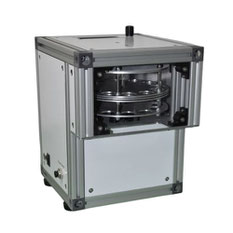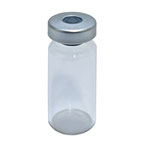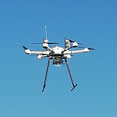Evacuate & Condition Vials for Whole Air Sampling
EV-101 Automatic Vial Evacuator and Purger

EV-101 Vial Evacuator. The instrument prepares evacuated vials for whole air (or soil water) sampling by drawing a vacuum, filling them (optionally) with helium (or other gas) and drawing a vacuum again. This is done by piercing the vial septa with a needle. The turret holds 12 vacuum vials (standard 20 ml size; sealed with 5 mm thick PTFE-lined grey butyl rubber stoppers and aluminium crimp caps (or similar)) for convenient batch conditioning. A custom EV-101 version for 10 ml vacuum vials or other vial dimensions can be produced on demand by adjusting the loading barrel dimensions. After vacuum is applied, crimp-sealed vials can be purged with synthetic air, helium (or similar) for 1 min at 200 mL min-1 using two G26 side port needles. The number of flush - evacuation cycles can be adjusted. Finally, the rinsed vials are evacuated using a rotary vane pump through a single G26 side port needle to a final pressure of approximately 0.5 Pa. Needles can be user changed if needed. The vial evacuator system has been laboratory tested to produce well evacuated vials with no contaminant gases after flushing. The evacuated vials / vacuum tubes can be used with a range of commercially available whole air sampling systems, including the Automatic Air Sampler AS-100 for lab and field use, and the UAV-based AS-110 Whole Air Sampler. Evacuated vials work with Rhizon soil water samplers to sample soil solution.
Vial Evacuator - Features
- Convenient batch operation for up to 12 vials, 20 ml
- Environmental friendly by reducing consumption of single use vacuum tubes
- User set flush and evacuation cycles
- User maintainable needle
Optional:
- Customization for other vial dimensions
| Reference | EV-101 Vial Evacuator | OPEN |
|
||
Vial Conditioning for Whole Air Sampling

- Conditioning of vacuum vials for whole air sampling typically involves the removal of any contaminants that might interfere with the analysis of the collected air sample. This is usually done by flushing the collection vessel with clean air or a specific gas (e.g. helium) prior to evacuating vials by a vacuum pump (Cambaliza et al. 2009). Multiple cycles of flushing and evacuation may improve the conditioning process. The best method used to condition evacuated vials depends on the type of sample being collected and the analysis being performed. Some common methods are: Continue reading
-
- Purge with clean air or a specific gas: This involves flushing the vacuum vial with synthetic air or a specific gas (usually helium) to remove any contaminants (incl. residual room air) that may be present. The vial or vial evacuator is usually connected to a gas source and the gas is allowed to flow through the glass vial for a set period of time before an evacuation cycle (vacuum back-fill, VBF).
- Bake: For cleaning the vials before purging, this involves heating the vial to a high temperature (typically around 200-250°C) to remove any non-gaseous contaminants that may be present. The vial is typically placed in an oven for a set period of time. This cleaning step can be implemented before vials are sealed with crimp-tops for subsequent purging and evacuation cycles.
- Silanisation: For conditioning vials for specific whole air sampling campaigns, this involves coating the inside of the vial with a silane compound to reduce adsorption of analytes. The vial is typically filled with the silane compound and allowed to react for a period of time before being purged with clean air or gas. A silanisation step can be implemented before vials are sealed for subseuqnt evacuation / purging with the EV-101. Alternatively, sorption tubes or Teflon-coated vials can be used for collecting reactive gas species / volatiles.
The interaction of the glass vial surface with the sampled air may become more important for some (e.g. 18O) analysis and for humid samples. Therefore, drying the sample during sampling, potentially by flushing the sampled air through magnesium perchlorate, and keeping the vials dry prior to sampling may minimise the potential effects of water and vial surface exchange. In general, Borosilicate- or Na-glass vials are frequently considered more suitable for gas sample tasks than e.g. polystyrole syringes (Rochette & Bertrand 2003). However, these authors and Knohl et al. (2004) suggested that the septa, rather than the (glass) vial itself, may be a major source of contamination. A possible mechanism could be a immediate contamination of vial contents by "slow closing" septa, diffusion of e.g. CO2 through the septa, or absorption or release of CO2 and other substances by the septa material. Thus the insertion of a more inert disc between (e.g. butyl rubber) septa and the gas sample may minimise the effect of contamination and increase the storage time of whole air samples. Potential materials for such disks are Polychlorotrifluoroethylene (PCTFE) or Polytetraflourethylene (PTFE). The pressure to which a vial should be subsequently evacuated for air sampling depends on the specific application and the analytical method being used. In general, the vial should be evacuated to a pressure low enough to ensure that the air sample is representative of the ambient air, but not so low as to compromise the vial. For most whole air sampling applications, the vial is typically evacuated to a pressure lower than 10 Pa (0.1 mbar), depending on the specific requirements of the analysis. The EV-101 is able to reach a low final pressure of approximate 0.5 Pa using a rotary vane pump. The advantages and disadvantages of specific conditioning methods depend on the type of air sample being collected and the analytical procedure. In any case, purging with clean, synthetic air or other inert gas before and between evacuation cycles is a simple and effective method that can be used for most whole air sampling applications. In any case, it is advisable to use external referencing (external standards), e.g. vials of air at ambient CO2 mixing ratio and known isotopic composition co-positioned in the autosampler, to minimize potential sample-based error sources and to determine the precision of the subsequent analysis.
In summary, it is important to use appropriate equipment and techniques to ensure that the most appropriate vial/septa types for whole air sampling are properly conditioned. The VSI EV-101 has been shown to meet all the requirements of a reliable vacuum vial conditioning device, with the flexibility to adapt to different vial geometries as required.
| References |
Conditioning and Air Sample Storage |
OPEN |
|
||
For whole air sampling tasks using unmanned aerial vehicles, consider our UAV-based sampling system.
For automatic whole air sampling into evacuated vials in the laboratory or field, the AS-100 air sampler has been developed.






